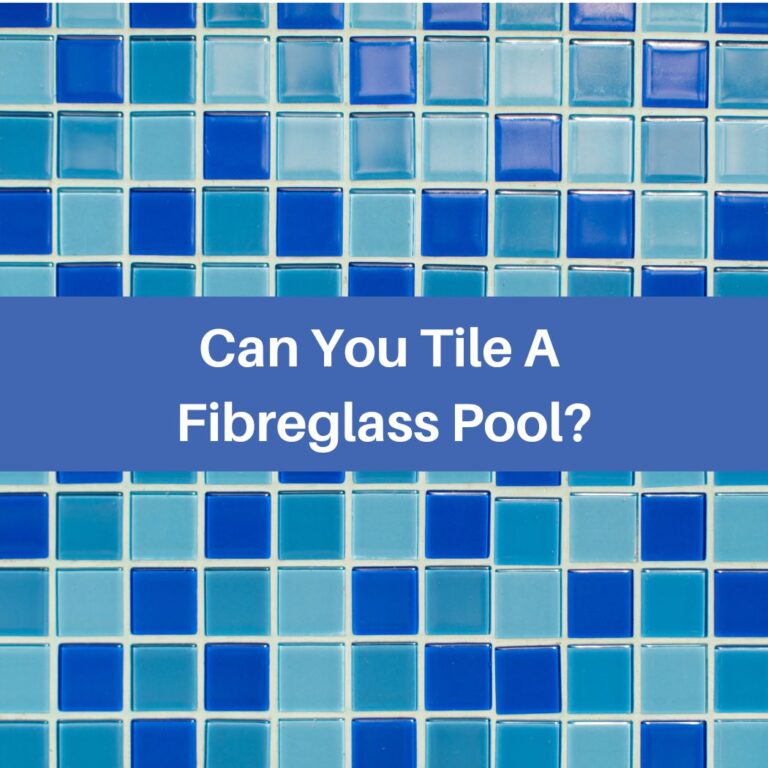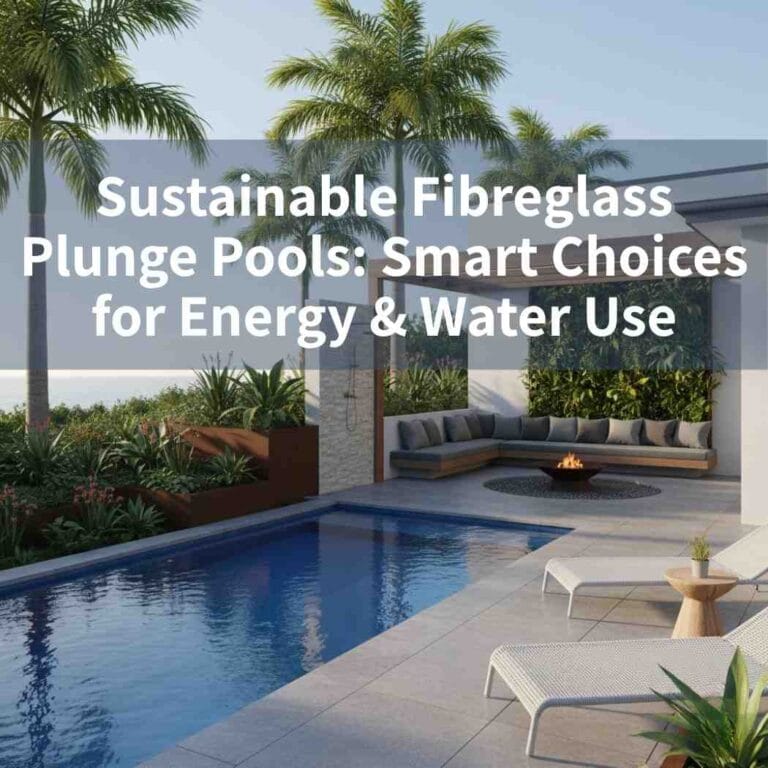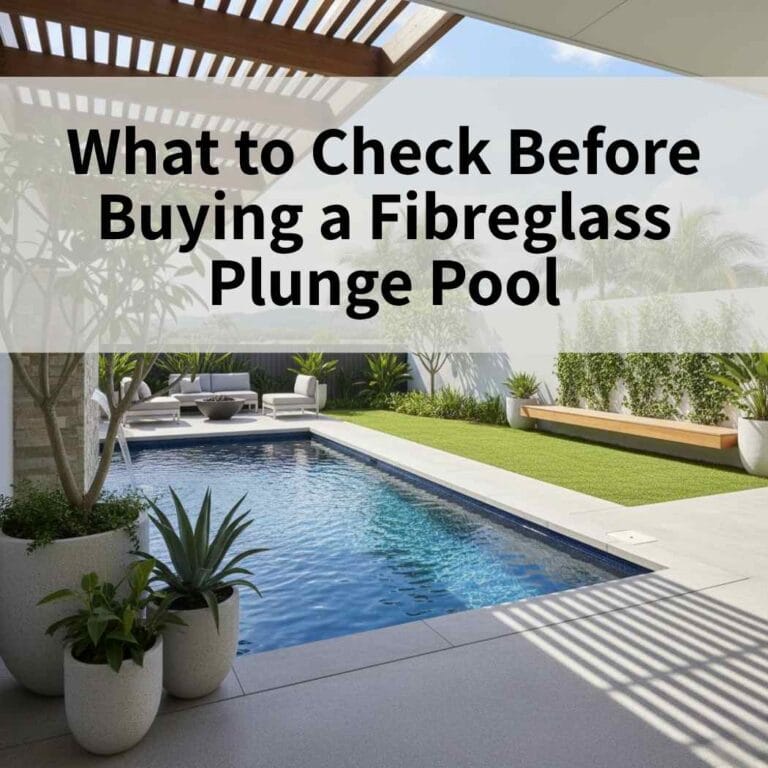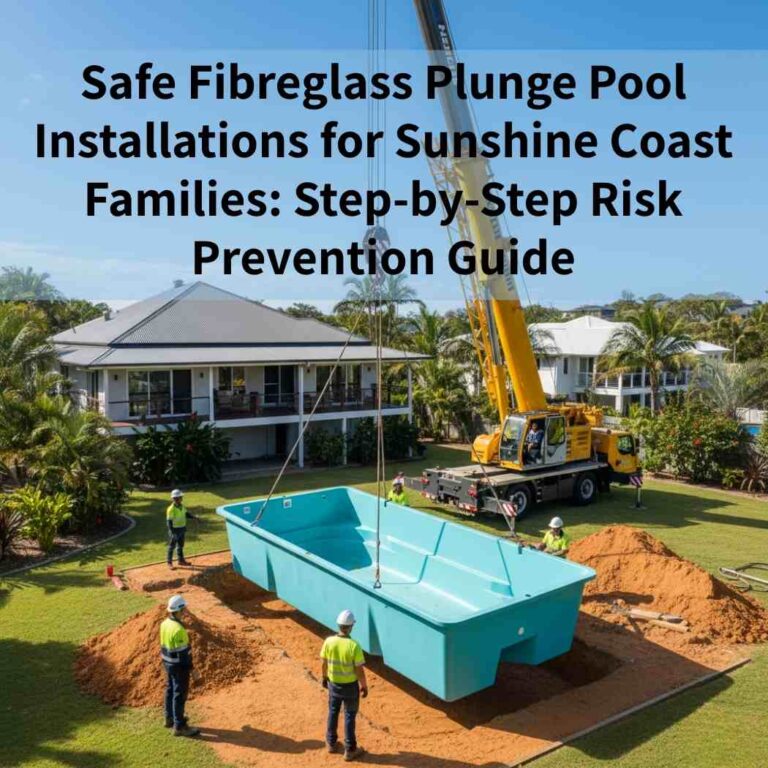What is the difference? A plunge pool differs from a regular pool primarily in size and purpose. Plunge pools are smaller, typically measuring around 2.4 to 3.6 metres wide and 1.5 to 1.8 metres deep, making them ideal for relaxation and hydrotherapy. Additionally, plunge pools require less water and maintenance due to their smaller size, making them a cost-effective option for smaller backyards.
Plunge Pools Sunshine Coast, recognised for its expertise in the industry, specialises in offering high-quality fibreglass and precast plunge pools tailored for those seeking a compact and efficient alternative to regular pools.
In this article, we will explore the differences between plunge pools and regular pools, highlighting their unique characteristics and benefits to help you make an informed choice for your outdoor space.
Table of Contents
ToggleBenefits of a Plunge Pool vs. Regular Pool
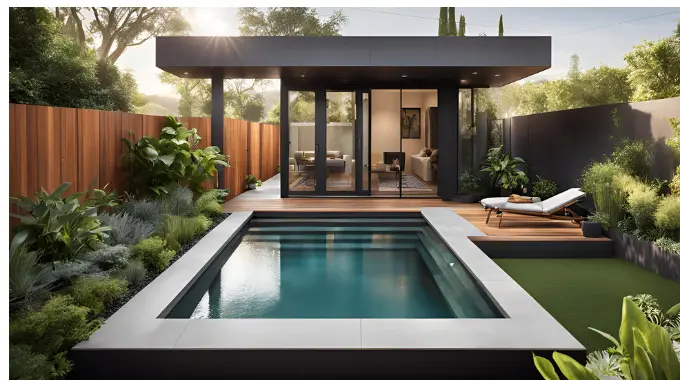
Advantages of Plunge Pools
- Space Efficient: Ideal for compact backyards due to smaller size.
- Stylish Design: Provides a posh place to cool off without bulk of full-sized pool.
- Lower Maintenance: Requires less upkeep due to their size compared to regular pools.
- Relaxation Features: Often includes spa jets for enhanced relaxation and hydrotherapy.
- Cost-Effective: Typically lower installation and heating costs, making them budget-friendly.
Disadvantages of Plunge Pools
- Limited Size: Smaller and primarily for relaxation, not suitable for swimming laps or games.
- Safety Concerns: Shallow depth can pose risks, especially for children.
- Crowding: Accommodates only a few people, making it less ideal for gatherings.
- Less Aesthetic Appeal: May lack the visual impact of larger pools.
Learn more:
What are the disadvantages of a Plunge Pool?
Advantages of Swimming Pools
- Versatile Usage: Suitable for swimming, games, and parties.
- Increased Property Value: Enhances home value and appeal to buyers.
- Family-Friendly: Offers more space for children to play safely.
- Aesthetic Impact: Serves as a stunning focal point in outdoor spaces.
Disadvantages of Swimming Pools
- Space Requirement: Designed for laps, water aerobics, and gatherings, requiring more space.
- Higher Maintenance: Ongoing maintenance is more demanding and costly.
- Recreational Limitations: May not fit in smaller outdoor areas.
What is a Plunge Pool?
A plunge pool is a small pool, compact in-ground or above-ground swimming pool, usually measuring around 2.5m – 3.5m wide and 3m – 6m long, with a consistent depth of around 1.5 – 1.8m. It’s designed for relaxation and cooling off rather than swimming laps, often featuring built-in seating and hydrotherapy swim jets.
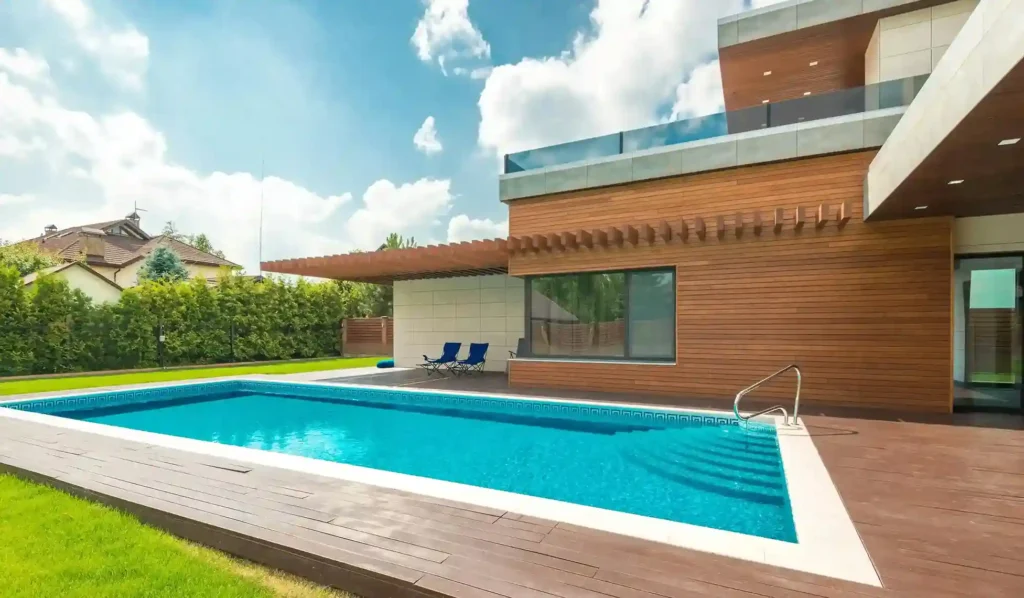
Characteristics of a Plunge Pool
Size: Plunge pools are typically much smaller than regular swimming pools, measuring around 2.5 to 3.5 metres wide and 3.5 to 7.5 metres long. This compact size makes them ideal for small backyards or urban settings where space is limited.
Depth: Unlike regular pools with varying depths, plunge pools have a uniform depth, usually ranging from 1.5 to 1.8 metres. This consistent depth allows for easy entry and exit and promotes relaxation rather than swimming laps.
Purpose: The primary purpose of a plunge pool is relaxation and cooling off, rather than swimming or engaging in water activities. They are designed for lounging and may include features like built-in seating and jets for hydrotherapy.
Seating: Many plunge pools feature built-in seating along the sides, providing a comfortable place to sit and relax. This seating arrangement enhances the pool’s functionality for lounging and socialising.
Versatility: Despite their smaller size, plunge pools can still be used for light exercise, such as water aerobics or resistance training. Some models can even be converted from a cold pool to a spa, offering year-round enjoyment.
Design Options: Plunge pools come in a variety of shapes, including circular, rectangular, and square, allowing homeowners to choose a design that complements their outdoor space. They can be customised with features like lighting, water features, and unique tiling to create a personalised look.
Easy Maintenance: Due to their smaller size, plunge pools require less water and chemicals for maintenance compared to regular pools. This translates to lower ongoing costs and less time spent on upkeep. Read more about Essential tips for plunge pool care.
Energy Efficiency: The compact size of plunge pools means they use less energy to heat and maintain, resulting in lower utility bills. This makes them an attractive option for homeowners looking to reduce their environmental impact and save money on energy costs.
What is a Regular Swimming Pool?
A regular swimming pool is a larger water feature designed for swimming laps, recreation, and socialising. Typically measuring 6 to 12 metres in length, these pools have varying depths for different activities. They can be customised with features like slides and heating systems but require more maintenance than smaller pools.
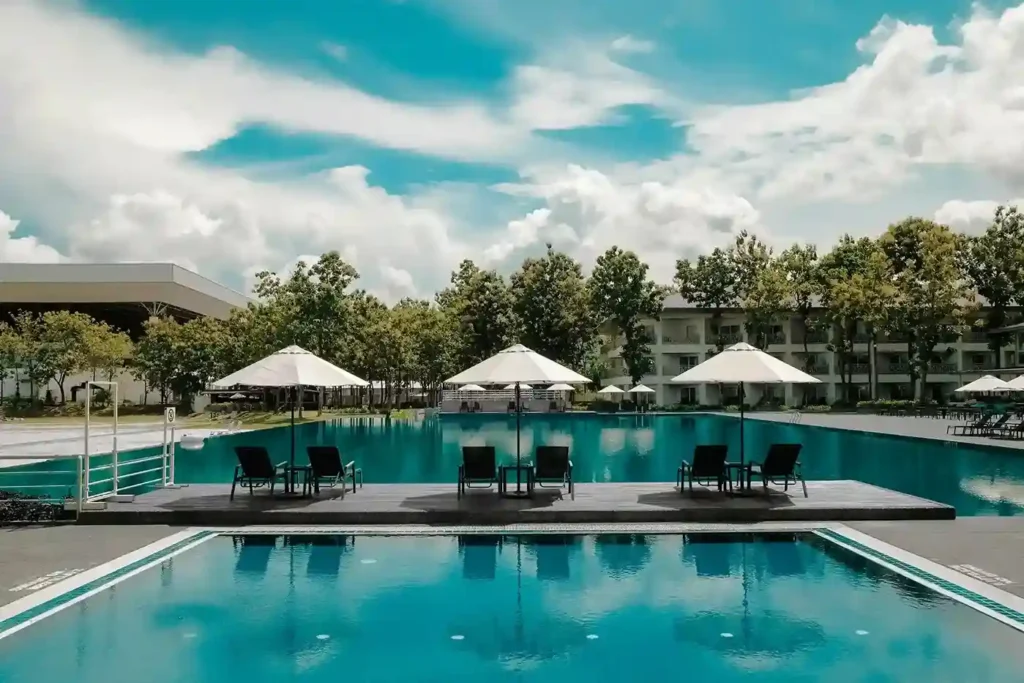
Characteristics of a Regular Pool
Size and Versatility: Regular pools are larger, typically ranging from 6 to 12 metres in length, allowing for various activities.
Depth Options: They offer multiple depth options, catering to both shallow and deep ends for different uses.
Recreational Use: These pools are designed for recreational activities, including swimming, games, and relaxation.
Customisation: Regular pools can be customised with features like slides, lighting, and landscaping to suit individual preferences.
Maintenance Requirements: They require regular maintenance, including cleaning, chemical balancing, and water circulation.
Heating Options: Heating systems can be added to extend the swimming season and maintain comfortable water temperatures.
Enhanced Property Value: Installing a regular pool can enhance property value and appeal to potential buyers.
Diverse Features: Regular pools can include diverse features such as waterfalls, spa jets, and lighting for added enjoyment.
Water Type: They typically use treated water, ensuring cleanliness and safety for swimmers.
Accessibility: Regular pools can be designed with accessibility features, making them usable for all ages and abilities.
Pool Size and Depth Comparison
What is the Size of a Plunge Pool?
A plunge pool typically measures between 2 to 3.5 metres wide and 2 to 5 metres long. The depth usually ranges from 1.5 to 1.8 metres, providing a uniform depth suitable for lounging and cooling off. Some plunge pools can be as small as 1.2 by 1.2 metres or as large as 4 by 2 metres, depending on individual preferences and space availability. Overall, plunge pools are designed to fit compact spaces while offering a relaxing water experience.
What is the Size of a Regular Pool?
A regular pool is typically ranges from 6 to 10 metres in length, with common sizes being 6m x 3m, 8m x 4m, and 9m x 4m. The average depth is around 1.7 metres. These pools are designed for various recreational activities, making them versatile for families. The specific size may vary based on yard space and individual preferences, but a pool size of 9m x 4m is commonly recommended for an average family.
Cost Considerations
Plunge Pool Cost: What to Expect
Average Cost
When considering the cost of a complete plunge pool installation, you can expect to pay between $40,000 and $60,000, with an average price around $45,000 – $50,000 for a small inground plunge pool (for both fibreglass and precast concrete shells).
Size of a Plunge Pool
The rule of thumb here is that larger pools generally cost more. Additional features like spa jets or custom designs can also add to the overall cost.
Ongoing Maintenance Costs
In terms of ongoing expenses, you should budget around $1,000 to $1,400 per year for maintenance, which includes cleaning and chemical balancing.
Regular Pool Cost: Budgeting for Your Backyard
Average Cost
The average cost to build a regular swimming pool in Australia ranges from $50,000 to $100,000+, with the typical cost being around $55,000 – $65,000. This includes the base pool, installation, landscaping, and fencing.
Factors Affecting Cost
The cost of building a regular pool can vary significantly based on several key factors:
- Pool type (concrete, fibreglass, vinyl liner)
- Pool size and shape
- Site conditions (sloping block, rocky terrain)
- Landscaping and decking
- Additional features (lighting, water features, spa)
Larger pools, irregular shapes, and complex designs will increase the overall cost.
Site Conditions
Challenging site conditions like sloping blocks, unstable soil, or rocky terrain can add $3,000 to $15,000 to the installation costs due to the need for extra excavation and site preparation.
Landscaping and Decking
Landscaping to repair damage from pool construction typically costs $3,000 to $5,000. Concrete decking is the most affordable option at $3,000 to $12,000, while premium materials like pavers or natural stone can exceed $20,000.
Additional Features
- Lighting and automation can add $5,000 to $10,000
- Water features like waterfalls or laminar jets cost an extra $10,000 to $20,000
- Outdoor kitchens and BBQ areas start at $30,000
Tips for Reducing Costs
- Choose a smaller pool size
- Select a simpler shape like a rectangle
- Use energy-efficient equipment
- Install a pool cover to reduce heating costs
- Do some maintenance tasks yourself
Conclusion
In conclusion, the main differences between lap pools and plunge pools lie in their size, purpose, and maintenance requirements. Plunge pools are smaller, deeper, and ideal for relaxation and hydrotherapy in compact spaces. They use less water and are more cost-effective to maintain compared to larger pools.
Swimming pools, on the other hand, are designed for swimming laps and exercise, requiring more space and ongoing upkeep.
When choosing between plunge pools and swimming pools, consider your available space, intended use, and budget.
Transform your outdoor oasis today—connect with our pool specialist and discover the plunge pool that perfectly fits your vision!
People Also Ask
How Big Are Plunge Pools?
Plunge pools are generally smaller than your standard pool, usually measuring between 2.5 to 3.5 metres wide and 2.5 to 6 metres long, with a consistent depth of around 1.5 to 1.8 metres. This dinky size makes them perfect for tiny backyards or city blocks.
How to Utilise Your Leftover Backyard Space?
If you’ve got some spare room out the back, chuck in a plunge pool. This little ripper offers the benefits of a relaxing dip without needing the massive space that a traditional swimming pool demands. You can also add some bells and whistles like a hot tub or some nice greenery to really jazz up your outdoor area.
What are things to consider before getting a plunge pool?
Before getting a plunge pool, think about these things:
- Space Availability: Make sure your backyard can fit a plunge pool without looking like a sardine tin.
- Purpose: Decide if you want a pool for chilling out or if you need room for a family pool or lap pool.
- Budget: The price of a plunge pool can vary heaps, so work out your budget and factor in ongoing maintenance costs.
- Design Options: Check out the different designs and features on offer, like swim jets and spa jets.
How do I know if a plunge pool is suited to me?
You’ll find that most plunge pools are perfect for those who want a compact, stylish pool option for relaxation rather than endless laps. If you prefer a small swimming pool for cooling off and having a few mates over, a plunge pool might be your go-to. But if you need space for swimming laps, you might want to look at a lap pool vs plunge pool.
Can a Plunge Pool be DIY?
While some parts of installing a plunge pool can be DIY, it’s often best to get the experts in, especially for in-ground plunge pools. They can make sure everything is installed properly, including the pool shell and any extra features, which can add to the cost but give you a better result in the long run.

